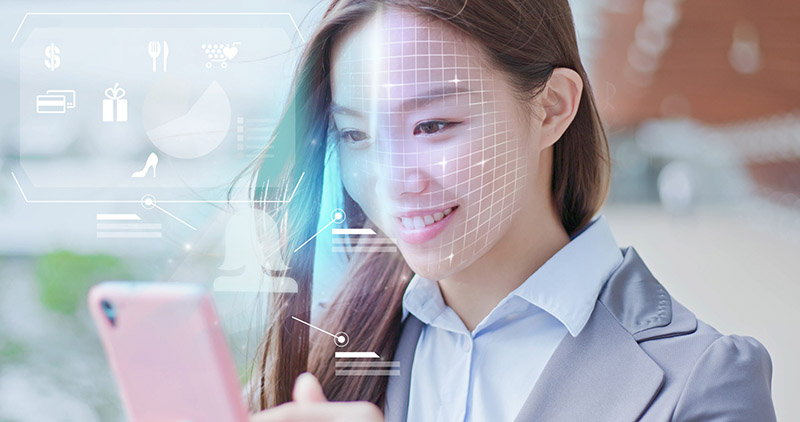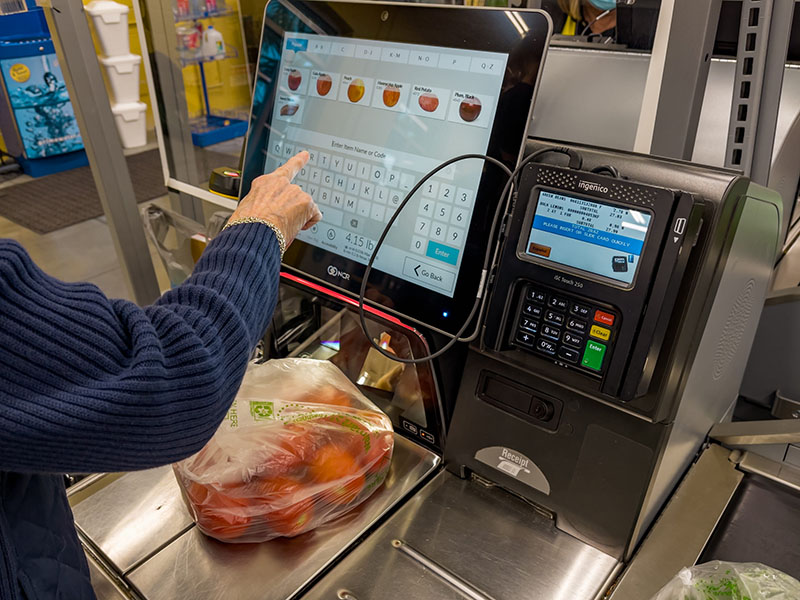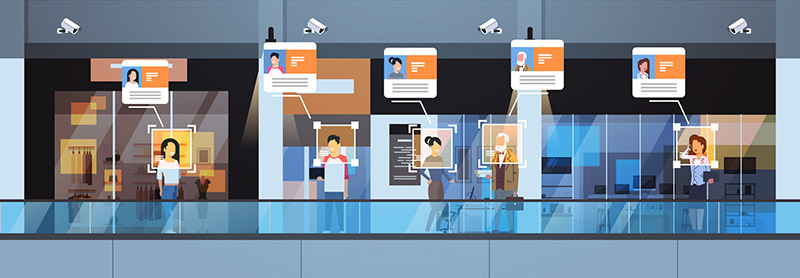In Today’s World
Facial recognition technology has quickly become integrated into our physical and digital lives. Many consumers first came into contact with facerec through the Face ID feature on the Apple iPhone X, which allowed users to unlock their device in place of a passcode. Face ID was the first mobile technology to create a 3D digital mapping of a user’s face. Android devices later implemented similar software, and both companies preached facerec was a secure alternative to the traditional passcode. Now a standard on most devices, consumers have become used to the convenience of scanning their faces. Learn more about Facial Recognition here!
Many retail enterprises are looking toward biometric technology as the future for their business’ security as well. With the rise of the self-checkout kiosk, facerec feels like a useful security measure. But when it comes to the workplace or a favorite retail store, many people are rightfully weary of the potential privacy concerns.
Transform your retail experience with facial recognition – Reach out to Bluefletch!
How Facerec Works

Facial recognition is a form of biometric authentication that uses machine learning and algorithms to “search, capture, and analyze facial contours” through a database of faces. The software creates then stores a 3D digital map of a person’s face which is accessed later to verify a user’s identification. Facial maps can be traced through photos or videos, giving more range for greater accuracy. The validity of the technology relies on the fact that every person has facial features unique to their biological traits, making facial recognition more secure than a character-based password. But it is vulnerable to numerous amounts of privacy issues.
Technologies & Cameras

Face recognition works best with some sort of camera or video capture device. There are a variety of different cameras and technologies that are facerec compatible. Including but not limited to:
- Mobile Device Cameras: Most Android, Apple, and other handheld mobile devices feature a front-facing camera that can be used for facerec. Cameras scan a user’s facial features and create a digital map that can grant access to their device and applications. In a retail environment, shared devices with facerec installed can increase the speed at which users can access a device. It also decreases the likelihood of a bad actor infiltrating a system. With facerec there is no need to manually enter a complex password, making both consumers and employees lives easier.
- Security Cameras: Facial recognition can increase security within homes, retail stores, and other public spaces. Some consumer-grade home security cameras have facerec, giving homeowners peace of mind knowing they may be able to ID an intruder. Many retail companies have begun utilizing similar cameras at self-checkout kiosks and other strategic points within a store. These cameras are ideal for stopping individuals who might create a dangerous situation or commit theft. When someone knows the store tracks their face, they may not want to risk getting caught. Facial recognition technology can also assist law enforcement in identifying criminals.
- POS Cameras: Point of sale terminals have become ubiquitous to the retail industry now that card payments are preferable over cash for businesses hoping to reduce person-to-person contact. Some POS terminals can be outfitted with facial recognition cameras, adding another layer of security to the checkout process. The checkout process also becomes quicker as some terminals can be self-managed while monitored by their camera system.
Facerec in Retail
Facial recognition technology can offer a wide range of benefits for retailers including, better end-user authentication, customer experience, and increased security.
Streamlined Employee Authentication: Facerec decreases the time it takes employees to authenticate on shared devices. Near instantaneous authentication gives access to all the necessary workplace systems and applications, minimizing the stress of remembering complex passwords. It is near impossible for a user whose digital map is not stored within the network to get into a device with their face. Additionally, some facial recognition technology can be used for physical locations as well, providing an extra layer of security for restricted, employees-only, areas.
Increased Customer Engagement: Many other retailers have implemented facerec cameras into the self checkout kiosks. Raydiant.com found that 60% of customers questioned in a survey preferred self-checkout. Facerec eliminates the traditional checkout process and frees time for employees to better assist customers and create a welcoming environment. HubSpot found that “93% of customers are likely to make repeat purchases with companies who offer excellent customer service.” Customers prefer an in-store experience that works at their convenience.
Faster Checkout: Amazon’s famous two-day Prime shipping changed the way people shopped online. Now Amazon has physical stores that do the checkout for you. Using their facial recognition technology, Rekognition, customers can shop without having to stop and pay. A specialized camera system works in tandem with Rekognition to automatically charge customers’ Amazon accounts. Customers are much happier not having to wait in line or rebag all of their items at the counter.

Uses of Facial Recognition in Retail
In addition to authentication and security, facial recognition technology has several other promising use cases for enhancing the retail experience:
Contactless Payments
Facial recognition technology can be integrated with payment systems to enable frictionless, touchless payments for customers. Shoppers can associate their face with a digital wallet or payment method one time. Then during future store visits, they can simply scan their face at checkout to pay, without needing to pull out cash, cards, or mobile devices. This provides added convenience and helps reduce contact during the pandemic.
For example, stores can equip self-checkout kiosks with facial recognition cameras to authenticate the customer and charge their account. Some integrations also allow customers to scan items as they shop and pay by face on the way out for the ultimate in convenience.
Personalized Advertising
Another use case gaining popularity is leveraging facial recognition to provide personalized and targeted advertising via digital signs and kiosks. Facial recognition can estimate age range, gender, sentiment and more to display dynamic ads tailored to the viewer.
Digital signage equipped with facial recognition cameras can instantly change displayed promotions when a teenager versus a middle-aged woman walks by. And an interactive kiosk can recommend top products on the fly based on the apparent age and gender of the customer using it.
Real-time Alerts
VIP customers and brand ambassadors are hugely valuable for retail stores. Facial recognition can help spotlight VIP visits by providing real-time alerts to staff when those individuals enter the premises.
Employees can receive a smartphone notification the moment a top customer walks in. Staff can then greet that VIP by name and provide personalized attention from the start.
Integrating facial recognition with existing CRM and loyalty platforms takes the VIP experience even further. Store staff can access full purchase history and preferences to make spot-on product recommendations for that loyal shopper during their visit.
Analyzing Facial Expressions
Understanding customer emotions provides useful insights for retailers. Facial recognition software can detect basic sentiments – happy, sad, angry, confused, disgusted, surprised, etc – by analyzing facial cues like wrinkles, frowns, smiles, and more.
Retail stores can monitor emotional responses at the shelf, checkout lanes, dressing rooms and more. This sheds light on pain points during the shopping journey. Do customers consistently display disgust at a certain product display? Confusion at your apparel sizing chart? Stores can address issues once invisible to them.
Employee Time Tracking
Lastly, facial recognition presents a huge upgrade over outdated punch-in/punch-out time tracking systems. Retail stores can have employees clock in and out simply by facing a camera or kiosk instead. This automates attendance tracking and makes it easy for managers to spot tardiness or absenteeism.
Preventing Theft
Facial recognition is also gaining ground in retail security. Stores can maintain databases of known shoplifters or organized retail crime offenders. Integrating such databases with in-store facial recognition cameras can alert staff if a recognized troublemaker enters the premises.
Studies show visibility of facial recognition signage also helps deter would-be thieves. Law enforcement can also leverage retail facial recognition systems by supplying databases of persons of interest when investigating local crimes. Elevate customer engagement through facial recognition – Book a demo today!
Loyalty Programs
Lastly, facial recognition integrates seamlessly with existing loyalty programs. Opted-in members can get automatic application of rewards points, coupons and discounts when the system recognizes them at checkout.
VIP members could also get customized suggestions across digital store displays. And staff can instantly pull up purchase history to provide personalized product recommendations when a top customer visits. Facial recognition helps cement brand loyalty.
Facerec & Retail Security
Reducing Theft: How many times have you seen footage of a store robbery on the news, but all you could make out was a blurry figure? Before facerec, a thief could disappear into the CCTV footage, leaving behind an unrecognizable face. Now, better quality cameras and advanced facial mapping can comb government databases. Potential thieves may deter from stealing, knowing their face is easier to identify with the power of facerec.
Increasing Retail Security: In a workplace where mobile devices, computers, and company systems are shared, facerec minimizes device theft or breaching that often occurs when only a password is between a hacker and your company’s data. Businesses spend thousands of dollars trying to protect their sensitive data such as employee and customer credit card numbers, bank information, addresses, and more. We’ve seen many large corporations get hacked and have thousands of loyal customers angry because their information was stolen. Facial Recognition relies on the unique biology of a user, making it far harder for bad actors to reach company databases. Facerec has the potential to reshape the way in which we approach business security by offering a more unique password replacement system. For more information on how to save money and increase security with password alternatives, check out our latest blog on SSO.
Not a perfect solution: While facial recognition offers a variety of security improvements, it is not perfect. Just like traditional passwords, facial mappings can be stolen. Facerec software stores users’ unique facial maps within a company network for cross-reference. Not only does this present a company security issue, but it also leaves employees vulnerable outside of the workplace. Their facial map may be associated with personal devices or other private systems. While the likelihood of a facial map being stolen is slim, it is still possible, and by no means in facial recognition impervious to a breach. It is, however, still a more secure alternative to a character-based password.
The Rise of Masks: However, with masks becoming a part of our new normal across the pandemic plagued globe, the effectiveness of this technology is threatened. Face coverings make it near impossible for a typical facial recognition system to ID an individual. The technology simply isn’t advanced enough to ID someone based on a quick picture of their eyes or the top of their head. This is a significant factor when considering how a retail store could implement facerec in their business.

Privacy Issues With Facial Recognition
With so much focus on innovating the digital world, many of us have become jaded to shiny new things that promise to improve our lives. But when it comes to building a more secure environment for retail customers and employees, some innovations are essential. We live in a time where the security of our identities, finances, and other personal business is in the hands of virtual technology. Just about everything that could compromise our livelihoods exists online. As many people begin to utilize the internet for groceries, shopping, and other errands, having a safe shopping experience is key. However, this quest for better security may forfeit our privacy. So, where do we draw the line between privacy and security?
Facial Recognition has become increasingly popular across industries such as travel, banking, retail, and law enforcement. Since the technology is still relatively new, there are many concerns about the potential privacy implications. Stolen facial maps can lead to stolen identities and a loss of control over personal information. If more and more retail stores and other consumer-based organizations begin to utilize facerec, it opens the door for hackers to gain access to someone’s identity, their financial information, and more.
As mentioned above, traditional passwords can be compromised as well. But because facial recognition relies on someone’s biology, there is much more at stake than a hacked account.
The Facerec Algorithm
Some organizations have already found that the technology is not advanced enough to detect everyone. AIs and other computer programs need machine learning to separate individuals from each other, this means cross-referencing images of real or sometimes digitally rendered people. If the pool of faces is not diverse in ethnicity and race, this can lead to algorithmic bias and discrimination. These issues are a reality of the new technology, and facial recognition bias is a problem that could potentially spell danger for a company, its employees, and its customers.
People have become increasingly wary of how their identity exists online. The rise in targeted ads, algorithms, and the buying and selling of personal information, has made a lot of people feel vulnerable and exposed. Not everyone is excited by the possibility of using their face in place of a password or trusting private corporations and governments to safeguard their digital identities.
Implement cutting-edge facial recognition in retail – Consult with our experts now!
Privacy of Retail Customers and Employees
Consumers have grown concerned that their faces may be stored in a company’s database, fearing a day where their digital facial maps are stolen and used for nefarious purposes.
Conversations about privacy in the retail industry began as some companies were outed for using facial recognition to track customers. If you’ve ever gone to a major retailer and used the self-checkout, you’ve probably noticed the little monitor and camera looking at you. These cameras can capture video footage and use government databases to track facial maps and information about anyone who has shoplifted or committed a crime.
While our culture has grown accustomed to being watched, knowing that your face is being mapped and stored in a retailer’s database is scary. Most customers do not want their identity used without their permission.
Conclusion
In conclusion, facial recognition is still a budding technology with a rich future of potential security and quality of life upgrades. While there are many ethical concerns around the potential privacy issues related to facerec, there are still ways in which our retail businesses can benefit from the technology.
If you found facial recognition interesting and wish to learn more about biometric authentication, check out our last article on How Biometric Authentication Enables a Secure And Efficient Workforce.
If you have any questions about how BlueFletch can assist your enterprise email us at info@bluefletch.com
